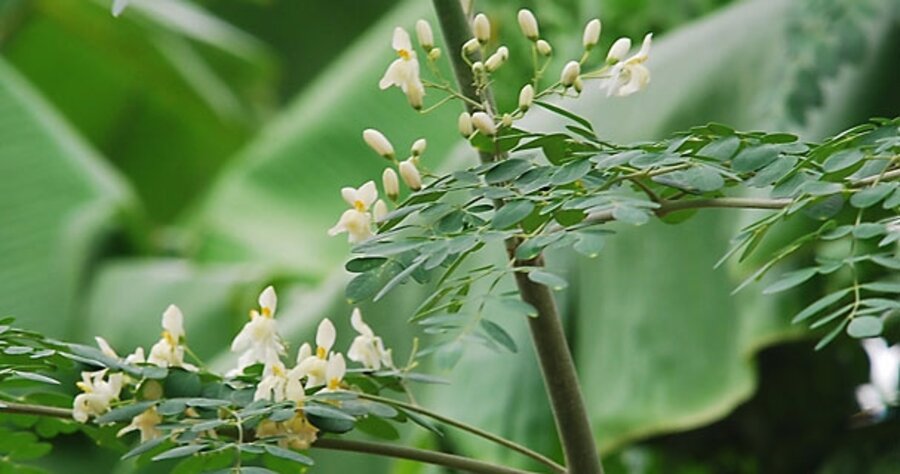A ‘miracle tree’ that could feed sub-Saharan Africa
Loading...
| Cambridge, Mass.
As a child growing up in India, I greeted the appearance of one particular vegetable on my plate with exaggerated distaste: tender seedpods from the moringa tree, locally known as “drumsticks.” Imagine my surprise when I heard a health worker from sub-Saharan Africa describe this backyard tree as a possible solution to malnutrition in tropical countries – he called it a “miracle tree,” no less.
Ounce for ounce, says Lamine Diakite, a Red Cross official from French Guinea in West Africa, moringa leaves contain more beta carotene than carrots, more calcium than milk, more iron than spinach, more Vitamin C than oranges, and more potassium than bananas. Its protein content is comparable to that of milk and eggs, and its leaves are still available for harvest at the end of the dry season, when other food may be scarce. Malnourished children gained weight when put on a timely dietary supplement made from the leaves, Mr. Diakite says. He passed around pouches of the green, hennalike powder at a recent international summit in Boston.
Until a decade ago, moringa was not widely known in Africa. Its leaves (boiled like spinach) were an occasional vegetable. Immigrant Indians prized the long, slender seedpods (stewed or cooked like green beans) as a delicacy. “But its nutritional value, newly ‘discovered,’ has been known for a long time,” says Lowell Fuglie, an international development administrator who has been instrumental in popularizing the moringa in Africa for the past 10 years. Laboratory analysis has corroborated traditional knowledge about the plant. It now awaits further validation by western science.
But even those who know moringa is edible don’t always exploit its nutritional value, particularly beneficial to those eating a carbohydrate-heavy diet (meat is often costly in Africa).
Senegalese people using moringa leaves to make mboum sauce, for example, discard the cooking water, which contains many nutrients, Mr. Fuglie says. His interest was sparked by research findings collated by the nonprofit Educational Concerns for Hunger Organization (ECHO). “Seeing moringa described as the most nutritious of all tropical vegetables,” says Fuglie, whose father worked for USAID in Africa, “I wondered why there was so much malnutrition in regions where the tree is easily grown and used.”
Species of moringa are native to the Indian subcontinent and pockets of Asia and Africa. One species in particular, Moringa oleifera, which has especially edible leaves, has become naturalized in other regions, says Mark Olson, an evolutionary biologist. Moringa growing wild on Mexico’s Pacific coast probably arrived long ago via the Philippines when Spanish galleons sailed between Manila and Acapulco, he says. He has traveled to remote areas to document the dozen or so species of the diverse, hardy native of the dry tropics. “It’s very hard to kill the moringa with drought or heat,” he says. Protein-rich plants like soybeans and legumes cannot survive such conditions or thrive in poor soil.
The fact that the leaves – and not just the seedpods and seeds – are edible makes moringa a desirable crop. The seeds also yield oil that could be used as biofuel, and ground seeds can help purify water. Parts of the tree are used in traditional medicine. It also grows rapidly (good for reforestation), reaching a mature height of 30 feet, though often it’s pruned annually to be as short as five feet, to keep leaves and seedpods within easy reach. It would be difficult to find a low-maintenance tree that offers more, says Fuglie.
In the 1980s, development workers began to hear of the tree. Its popularity grew by leaps when Fuglie began to promote the shade-dried leaf powder as a food supplement, says Martin Price, director of ECHO. Reports from Fuglie’s pilot nutrition project were persuasive.
Still, there have been no clinical human trials to quantify the moringa’s role in fighting malnutrition, says Jed Fahey of Johns Hopkins University. He is a volunteer for Trees for Life International, a group that promotes planting moringas. Based on centuries of human consumption, however, a strong case can be made that eating the leaves causes no harm, says Dr. Fahey, a phytochemical researcher.
But because there is no definitive dietary study on the moringa, the scientific community and relief agencies still have reservations. Fuglie predicts that more moringas will be planted once aid organizations are convinced of the leaves’ nutrition. Fuglie needs no persuading: If you had to design an affordable source of enriching supplements for the dry tropics, he says, “it may be impossible to come up with anything better than the moringa.”





